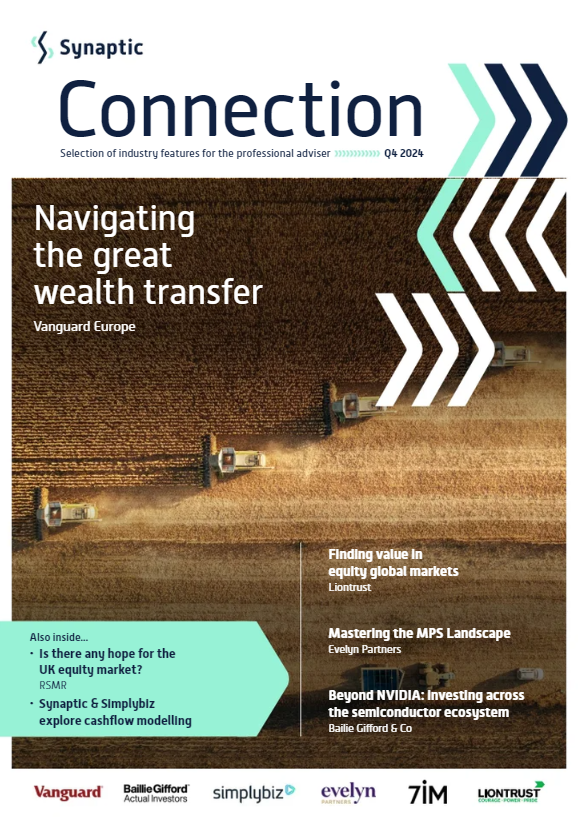In this edition...
- Navigating the great wealth transfer Warwick Bloore, Senior Specialist, Adviser Research Centre - Vanguard Europe
- How to keep up – tackling the risks of regulatory change Gareth Johnson, Head of Investment, Management Compliance - Simplybiz
- Beyond NVIDIA: investing across the semiconductor ecosystem Helen Xiong, Deputy Manager, Monks Investment Trust - Baillie Gifford & Co
- Finding value in global equity markets John Husselbee, Head of the Liontrust, Multi-Asset Investment Team - Liontrust
- Enhanced cashflow modelling Seb Marshall, Product Manager - Synaptic
- Worldly wisdom of The Wire Ben Kumar, Head of Equity Strategy - 7IM
- Mastering the MPS Landscape Mastering the MPS Landscape, Managing Partner, Head of UK IFA Services - Evelyn Partners
- A practical guide to getting your ongoing reviews in order Jennifer Peaty, Director of Regulatory, Consultancy and Advice Quality - Simplybiz
- Is there any hope for the UK equity market? Katie Sykes, Client Engagement & Marketing Manager - RSMR
- Cash-flow modelling Sandy McGregor, Head of Policy - Simplybiz
 FCA asks firms to review their use of cash-flow modelling.
FCA asks firms to review their use of cash-flow modelling.
Whilst the Thematic Review into Retirement Income publication in March 2024 has been at the forefront of much discussion in recent months, it is important not to overlook an important FCA article that flanked the publication. This article was on the use of cash-flow modelling to demonstrate suitability of retirement-related advice.
Cash-flow modelling (CFM) has come to prominence recently as the FCA has raised concerns of how firms were monitoring income sustainability. Whilst the FCA stopped short of stating all firms should adopt cash-flow modelling, it did reference CFM’s “significant role” in educating a customer around the strategy being recommended and assessing capacity for loss. As with most financial planning tools, the potential usefulness is dependent upon what inputs and assumptions are used; if used incorrectly, they can create misunderstanding and lead to unsuitable advice. CFM can be a key step in providing suitable advice, helping to establish a client’s true monetary capacity for loss in retirement.
A key component to successful use of CFM is the accuracy of information, incorporating all of a client’s assets. Many advisers will have clients who have - either knowingly or innocently - excluded assets. cash-flow modelling, when co-completed with the client - which may prevent certain assets going missing - can be a powerful addition to a retirement income file, providing retiring clients assurance that they have enough savings to sustain their desired lifestyle and achieve their retirement goals.
Firms should also be aware of the FCA’s expectations around CFM use in other related areas of advice. CFMs should ensure tax bands and limits are based on reasonable assumptions and projected investment returns are justifiable, consider all relevant tax charges, and include stress-testing scenarios. Conducting thorough fact-finding and suitability assessments helps cash flow modelling to meet the individual retirement needs, objectives, and risk tolerance of each client. All CFM should show figures in real, not nominal, terms. It should be clear to clients how much future income amounts are worth in today’s money terms, i.e. after inflation has been considered. Using real terms should also help adjust tax bands and other tax limits more easily. A recommendation would be for firms to adopt a policy for the use of CFM documenting all assumptions, justifications, and stress testing scenarios to be used across the firm. This not only provides a clear record of the retirement advice provided, but also can drive consistency of use in multi-adviser firms, essential for compliance and for facilitating audits.
The FCA has encouraged firms to embrace technology to deliver improvement in the advice process. Dovetailing nicely into the findings of the Thematic review, cash-flow modelling software provides the opportunity for firms to address the areas for improvement such as Income Withdrawal Strategy / Methodology, providing there is consistency of assumptions used in the steps prior to cash-flow. Most tools incorporate risk profiling results from the earlier stages of the advice process which pull into the cashflow seamlessly, with the software being able to adapt to several drawdown strategies. Crucially, all current and future income and expenditure requirements can be modelled, along with other individual scenarios.
“If a client understood returns were based on assumptions about how the market would perform, they were less likely to withdraw more than they could afford from their pension or investments."
Firms should fully understand the cash-flow projections they are producing for clients and whether the output they have generated is a representation of the client’s true retirement future, considering all the assumptions made in constructing the CFM, and sense-check any outputs. Alongside considering their own understanding of the projections, when presenting cash-flow outcomes the firm should make the client aware any figures presented will not 100% be borne out in practice. If the risks aren’t properly explained, a client may perceive a degree of certainty in the outcomes that does not exist.
This may make client reviews easier for firms as, according to the FCA, “if a client understood returns were based on assumptions about how the market would perform, they were less likely to withdraw more than they could afford from their pension or investments”. This extends into the Consumer Duty; feedback from clients on how the CFM improved their confidence or understanding of their situation could be valuable in illustrating how firms are adding value and meeting Consumer Duty requirements.
If there is a takeaway from recent information requests it is that firms should complete effective due diligence and oversight on third-party service providers and tools, including CFM software. Firms should satisfy themselves that tools are fit for purpose for client’s needs. Regular reviews should be conducted, usually annually, with firms able to evidence the research they have undertaken to choose the CFM software they’re using.
The most important part is understanding that a snapshot in time is taken of a client’s finances with a CFM, and CFM exercises can ultimately prove to be wrong. The calculated rates of growth, income, tax, and so on which are used to form the basis of the CFM analysis require regular reviews and reassessments to ensure client’s objectives remain on track. CFM enables clients to receive insights into how events impact their ongoing financial position. From a qualitative perspective, it enhances an advice proposition and helps advice to be to your clients’ specific needs and objectives but also - in a world where there is so much emphasis on value - it will enhance how firms quantify the value of their proposition.
In summary, when you use cash-flow modelling, it is essential that you revisit your proposition in light of this important little FCA article published alongside the main Thematic Review.
Get in touch:
www.simplybiz.co.uk
01484 439100
info@Simplybiz.co.uk
Sign up for updates
Keep up to speed with everything you need to know each quarter, by email or post.


